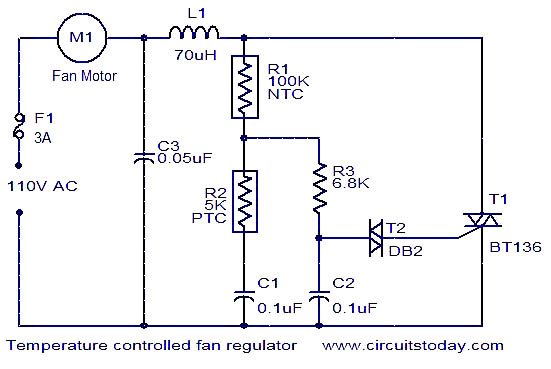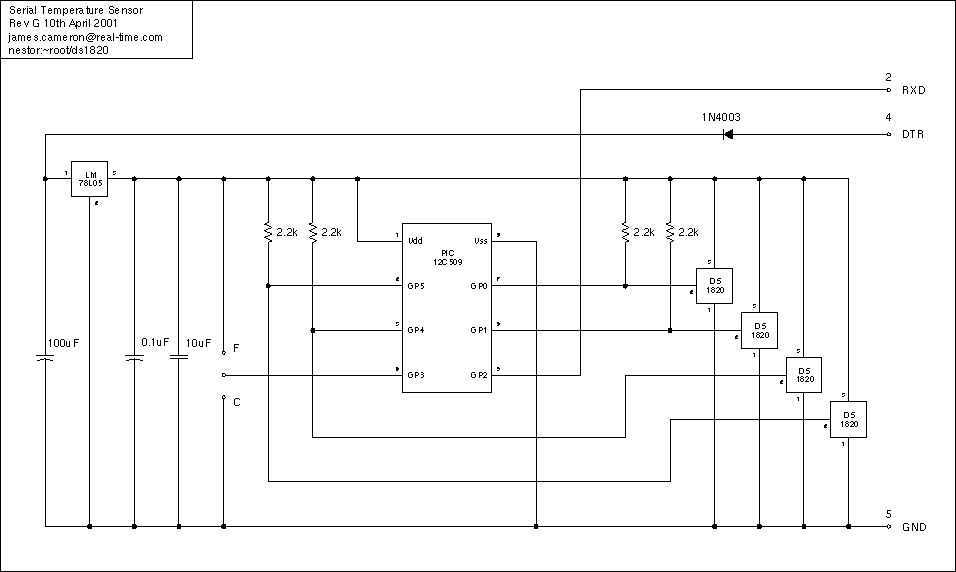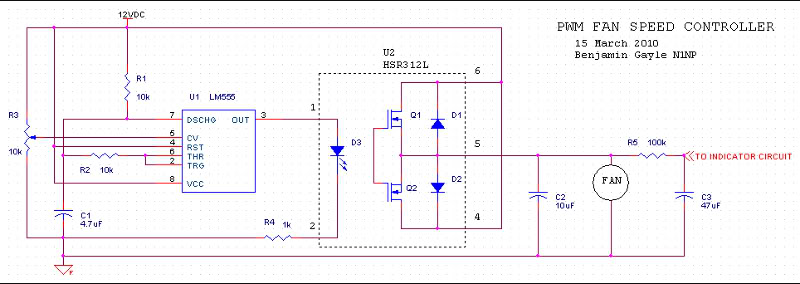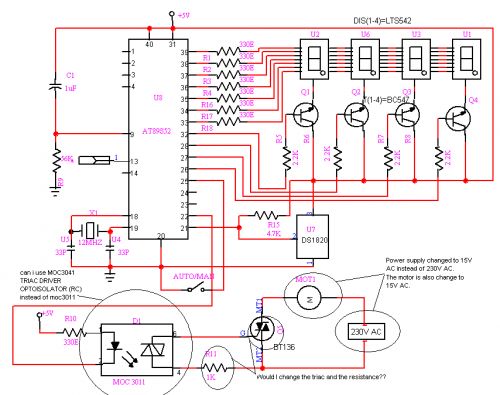
Temperature controlled fan regulator

This fan regulator circuit automatically controls the speed of a fan based on temperature. It utilizes two thermistors (R1 and R2) for temperature sensing. The operation is similar to previously published designs, with thermistors replacing the potentiometer. As the temperature rises, the resistance of the NTC thermistor (R1) decreases, while the resistance of the PTC thermistor (R2) increases. The rate of change in resistance differs between R1 and R2, mimicking the function of a potentiometer in a conventional TRIAC-based fan regulator. Variations in resistance adjust the firing angle of the TRIAC, thereby altering the fan's speed.
The fan regulator circuit employs a TRIAC (Triode for Alternating Current) as the main switching component, which allows for control over AC power delivered to the fan. In this design, the NTC (Negative Temperature Coefficient) thermistor (R1) decreases its resistance with increasing temperature, providing a lower resistance path that increases current flow. Conversely, the PTC (Positive Temperature Coefficient) thermistor (R2) increases its resistance with rising temperature, limiting current flow and creating a differential response to temperature changes.
The interaction between R1 and R2 generates a variable voltage that is fed into the gate of the TRIAC. The TRIAC's firing angle is controlled by this voltage, determining the duration for which the TRIAC is conductive during each AC cycle. This results in a proportional adjustment of the average voltage supplied to the fan, effectively controlling its speed.
To enhance performance, the circuit may incorporate additional components such as capacitors for filtering or diodes for protection against reverse polarity. A heat sink may also be employed on the TRIAC to dissipate heat generated during operation, ensuring reliability and longevity of the circuit. Additionally, careful selection of the thermistors' characteristics is crucial to achieve the desired response time and sensitivity to temperature changes, allowing for effective fan speed regulation in various environmental conditions.This fan regulator circuit will automatically control the speed of your fan according to the temperature. Two thermistors (R1 and R2) are used to sense the temperature. The circuit works almost like the published here previously. Here the potentiometer is replaced by the thermistors. When the temperature is increasing the resistance of NTC thermis tor ( R1) decreases and at the same time the resistance of PTC thermistor (R2) increases. At the same time, rate of change of the resistance will be different for R1 and R2. This action is similar to a potentiometer used in a conventional Triac based fan regulator. When the resistance is varied the firing angle of the triac changes and so do the speed of the fan. 🔗 External reference
The fan regulator circuit employs a TRIAC (Triode for Alternating Current) as the main switching component, which allows for control over AC power delivered to the fan. In this design, the NTC (Negative Temperature Coefficient) thermistor (R1) decreases its resistance with increasing temperature, providing a lower resistance path that increases current flow. Conversely, the PTC (Positive Temperature Coefficient) thermistor (R2) increases its resistance with rising temperature, limiting current flow and creating a differential response to temperature changes.
The interaction between R1 and R2 generates a variable voltage that is fed into the gate of the TRIAC. The TRIAC's firing angle is controlled by this voltage, determining the duration for which the TRIAC is conductive during each AC cycle. This results in a proportional adjustment of the average voltage supplied to the fan, effectively controlling its speed.
To enhance performance, the circuit may incorporate additional components such as capacitors for filtering or diodes for protection against reverse polarity. A heat sink may also be employed on the TRIAC to dissipate heat generated during operation, ensuring reliability and longevity of the circuit. Additionally, careful selection of the thermistors' characteristics is crucial to achieve the desired response time and sensitivity to temperature changes, allowing for effective fan speed regulation in various environmental conditions.This fan regulator circuit will automatically control the speed of your fan according to the temperature. Two thermistors (R1 and R2) are used to sense the temperature. The circuit works almost like the published here previously. Here the potentiometer is replaced by the thermistors. When the temperature is increasing the resistance of NTC thermis tor ( R1) decreases and at the same time the resistance of PTC thermistor (R2) increases. At the same time, rate of change of the resistance will be different for R1 and R2. This action is similar to a potentiometer used in a conventional Triac based fan regulator. When the resistance is varied the firing angle of the triac changes and so do the speed of the fan. 🔗 External reference





